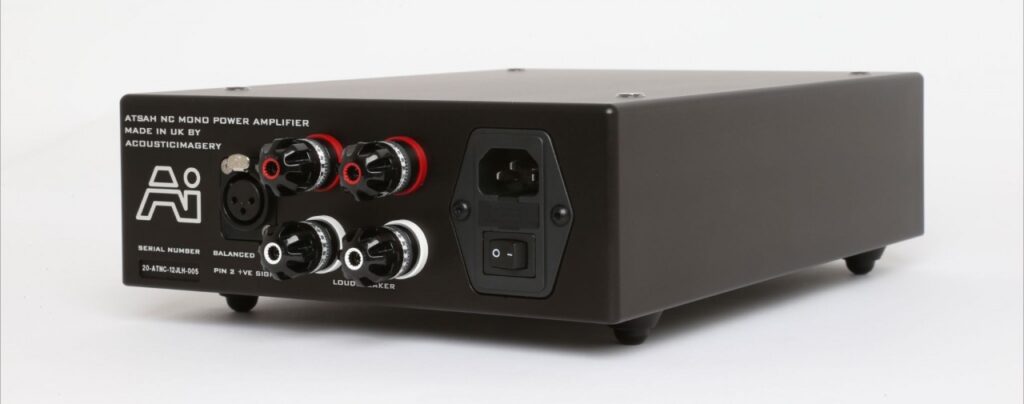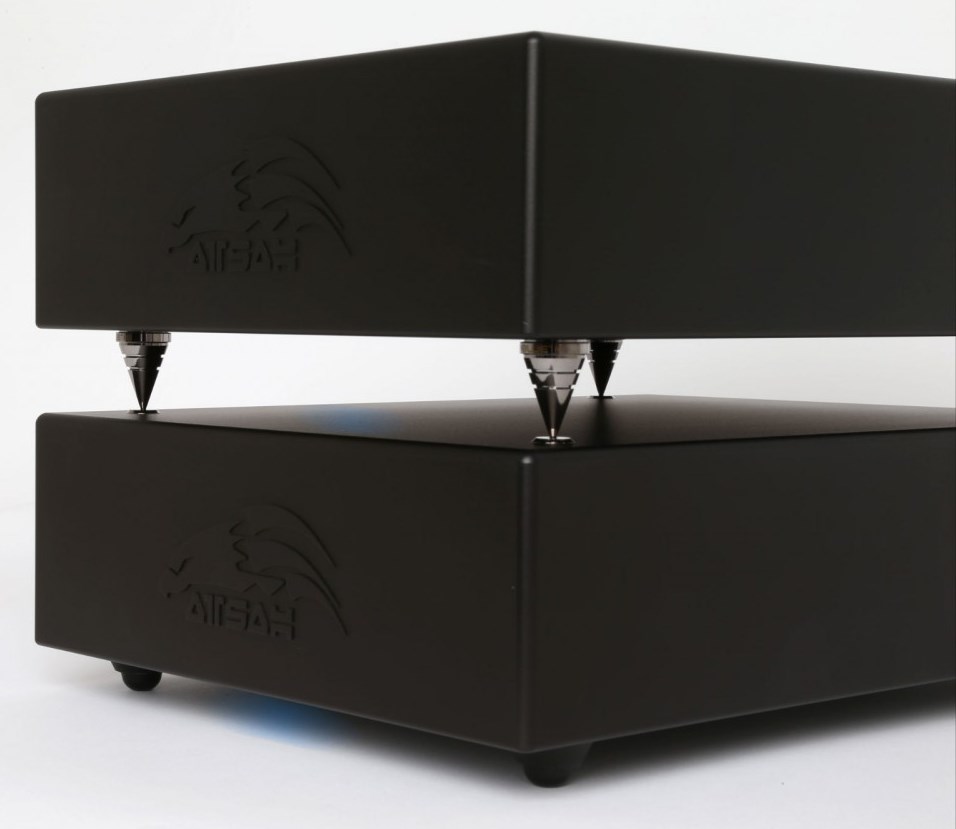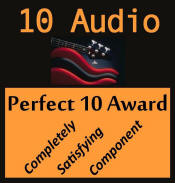The Acoustic Imagery Atsah power amplifiers are rated at 400 Watts per mono chassis and carry a list price of $8995 per pair. Besides a power rating that would be a good fit in a system of any size, the amplifiers have a signal-to-noise ratio of 128 dB, which means they can be expected to add very little of their own character to the musical signal passing through. Let’s see if this assumption is true.
“Atsah” was chosen as the name for these amplifiers by John Young, the UK-based owner of Acoustic Imagery. Atsah is the Navajo word for “eagle”. The Navajo language made a comeback during World War II when a number of the Navajo tribe were employed as “code talkers” by the US. Our foes never did break the “code” of the Navajo language and were unable to decipher the tactical secrets that were being communicated by our honored Native American ancestors.
I was fortunate to meet John and his partner, Hilary Russ, at the 2013 Rocky Mountain Audio Fest. However, it was not purely a social meeting, although both John and Hilary are charming and kind folks. I had been auditioning the Atsah amplifiers for about a month and this meeting included a business agenda item: I wanted to purchase the amplifiers. Let me tell you why.
The Atsah amplifiers are based on the NCore 1200 Class D amplifier modules. You might be familiar with other, new tech amplifier modules such as ICEpower (the best-known example), T-Path, Hypex UcD, and others. The NCore modules also come from Hypex. They offer an NC400 module to do-it-yourself hobbyists. The NC1200 module is sold only to manufacturers. The amplifier modules and their matched switch-mode power supplies are housed in heavy KASTAL 300® aluminum enclosures and feature two pairs of WBT® – 0703 nextgen™ binding posts for bi-wiring and Neutrik XLR connectors for inputs. No RCA inputs are included, although RCA to XLR adapters are widely available.
The review system included a Basis 2500 Signature turntable with Vector 4 tonearm, Miyajima Kansui and Zu Audio DL-103R moving coil cartridges, PS Audio NuWave Phono Converter, Sutherland 20/20 and Sutherland DUO phono preamplifiers, Mark Levinson 326S preamplifier with phono, Prism Orpheus Digital Interface and Lynx Hilo AD/DA converters with custom Windows 7 computer/music server, YG Acoustics Kipod II Signature Main Modules speakers, Magnepan 1.7 and 3.7 speakers, Dali Mentor 5 speakers (from the home theater system), and two Gallo TR-3 and TR-3D subwoofers. I have been enjoying the Spread Spectrum Ampzilla 2000 Second Edition power amplifiers for almost 2 years. Interconnects and speaker cables are mostly Mogami. All front end components receive their AC power from a PS Audio AV-5000 power conditioner, which is connected to the wall power with a Shunyata Anaconda CX power cord. A PS Audio Quintet, connected to the utility grid with another slithering Anaconda CX, is normally used for the power amplifiers. A variety of power cords are used elsewhere in the system, including Wyred4Sound P1 and Jerry’s DIY power cords which can be found on the music computer, Prism Orpheus, and Levinson preamp.
I can foresee someone thinking the upper frequencies are a little on the cool side. That opinion would be the result of a too-short comparison to a more conventional solid state amplifier sound or to a classic tube amplifier sound. I made that mistake, which, on further listening, proved that short auditions are sometimes misleading.

The upper frequencies, where we often expect a digital footprint, do not attract special attention. This would be a character that is below the level of refinement that the Atsah amplifiers easily provide. The correct amount of treble content, resolution, clarity, and speed is present. That is all. After a time one notices an absence of a fine haze or fog that many other otherwise fine amplifiers seem to add. This is the source of the somewhat cool immediate impression. The sound is never hyped, highlighted, dry, diminished, sweet, cold, or any other audiophile adjective, except “natural”. The entire treble range simply is. The extraordinary resolution is certainly enhanced by the state-of-the-art specs for signal-to-noise ratio and the very low THD of about 0.0015% at 100 Watts. Interestingly, THD decreases with increasing power output.
There is a remarkable cleanness and very apparent freedom from distortion, fuzz and grain in the upper frequencies that will challenge your expectations. In addition to this remarkable clarity there is truly revelatory low level resolution that continuously reveals unknown harmonic content. This adds body and believability to everything you hear. Since the early days of CD, back in the early 1980s, we have become accustomed to excellent bass reproduction from digital technology. Now, with the Acoustic Imagery Atsah amplifiers, we enjoy the same excellent quality sound in the upper frequencies. As Darth Vader told Obi-wan (Star Wars IV), the circle is now complete. The promise of digital amplifier technology is fulfilled.
This seemingly limitless resolution is apparent across the musical frequency range, from subterranean low bass to dog-whistle upper treble. The ability to follow individual instruments and voices as separate and distinct sounds in the mix is truly outstanding. This might be the defining trait of these amplifiers which sound the same at any frequency and at any volume level. The result is a very harmonically rich sonic fabric that not only provides endless new insights into your favorite music, but is also very enjoyable. This satisfies both our left-brain analytical side and right-brain artistic side. You could easily call this character “faultless”.
The bells near the end of Donald Fagan’s “The Goodbye Look”, from The Nightfly, are delivered with a “sounds real” presence. The first time I played this cut, the bells sounded undifferentiated and jangly, but after an overnight warm up, the amps delivered correct sound. The sounds of a piano, in any recording, sound as true to the instrument as the recording allows.
The performance is the same from low bass into the treble. The amplifiers are absolutely linear in terms of tonal balance and resolution. There is no highlighting or added focus on any particular range of frequencies. There is a pervasive lack of blurring of any sound which allows every bit of harmonic content to define a rich and densely saturated sound field with a huge sense of space. The air is alive. This presents a very realistic, focused, wide and deep sound stage for your continual enjoyment.
The purity of the sound and freedom from distortion is quickly addicting. When you are hooked, a simple truth is revealed: The bar for high end sound quality has just been raised. You might have experienced the audiophile clichés about a newfound clarity “removing a veil” or “cleaning a window”. Well, friends, as Luke Bryan sings on his Tailgates & Tanlines CD, “You Don’t Know Jack”. With the Atsah amplifiers, it is not a diaphanous veil that is eliminated, but a wool blanket. And the dirty window is not simply cleaned, but a pair of large French doors is flung wide open, revealing a huge sun drenched balcony overlooking a pristine panorama. This certainly raises the bar for what is possible in this – or a much more dear – price range.

The sealed enclosures run about 97 degrees F at idle and 100 degrees when the amps are putting out a lot of power. They draw about one-half amp of power per chassis at idle, and not much greater at high volume levels. As mentioned above, it takes at least an hour of power-on time to reach an optimum sound quality. The power switch is on the back, an indication they are designed to be left powered on continuously. The blue power light is mounted on the bottom of the chassis near the front and casts a gentle blue glow under and around the amplifiers. This is a very nice design innovation. As mentioned in my review of Audio Horizons Platinum Reference Fuses, these fuses offer a very worthwhile sonic upgrade over standard glass fuses.
One of the primary goals of a home audio system is to give the listener the feeling of being present at the original performance. The Atsah amplifiers meet this goal exceedingly well due to their very holographic sound stage, revelatory resolution, and consistent tonal quality across the audible frequency range. Their small, 93% energy efficient, 6 kg package offers easy placement in any system configuration.
Yes, I bought them. And every time I listen to music, I am glad I did. No one should buy any power amplifier at any price until they hear this technology. It is truly a game changer for the product category “power amplifiers”. Many of you will get off of the amplifier “merry-go-round” and have a long-term relationship. The Acoustic Imagery Atsah power amplifiers easily and always meet the requirements of our Zen Test and earn their superlative 10 Audio “10 LP” rating.
Overall Rating: 10 LPs

Link to manufacturer: Acoustic Imagery
My thanks to Michael Garner at TweekGeek.com. This review would not have been possible without Michael’s kind assistance.
Update early 2016: The above results were obtained almost exclusively with Magnepan 3.7 speakers, with which the Atsahs work spectacularly well. While the amps work well with my newer Focal Chorus 714 and Emerald Physics 4.7 speakers, the overall rating of the Atsahs with these speakers is 9.5 LPs.
